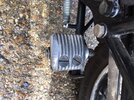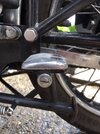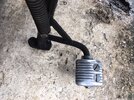That means the tube has a reducer in it. I made up for the weight by using 6061 T6 aluminum for the side plates which I think will withstand the weight. I'm also thinking about using aircraft streamlined tube for the legs which should look a lot spiffier than round legs. The same shape may be used for the actuating arm on the left leg if I
can fit it in. Again, it will be more streamlined than the round rod, plus it may give a bigger foot print for one's foot.
I want a lot larger feet too, curved from the point of touch-down so I'm working on the transition from streamline tube to flat foot.
can fit it in. Again, it will be more streamlined than the round rod, plus it may give a bigger foot print for one's foot.
I want a lot larger feet too, curved from the point of touch-down so I'm working on the transition from streamline tube to flat foot.
I don't think Dave would have wanted the weight of a heavy wall tube.



